
by Bethany Augliere Wednesday, November 30, 2016
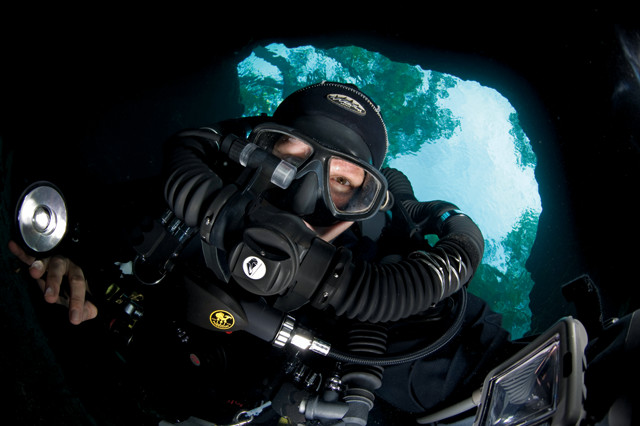
Jill Heinerth enters the cave at Devil's Eye Spring in Florida. Credit: Jill Heinerth, IntoThePlanet.com.
Jill Heinerth has trekked farther into caves than any woman in history, logging more than 7,000 dives across every continent and descending as far as roughly 140 meters underwater — recreational divers only reach depths down to 40 meters. She has dived inside icebergs in Antarctica, beneath the Sahara Desert, and in the turquoise waters of the Bahamas.
Cave diving is considered technical diving, which means there is no direct route to the surface, and it can be a dangerous endeavor. Despite the danger, Heinerth journeys through Earth’s watery depths with a mission: to share her experiences and teach people about our planet’s finite freshwater resources.
Growing up in Cooksville, now Mississauga, Ontario, Canada, Heinerth always enjoyed the outdoors. She and her family would often camp, hike and canoe. Although her parents were not divers, they always encouraged her to “work hard and dream big,” Heinerth says. She wanted to become an astronaut as a kid, and dreamed of exploring space. But that option wasn’t readily available to her. So, she turned her attention to caves instead, and became an aquanaut.
Heinerth earned a Bachelor of Fine Arts in Visual Communications Design at York University in Toronto. After graduating, she split her time between running a graphic design business during the week and diving on the weekends, in Lake Huron of Tobermory, Ontario. But office walls — even part-time — didn’t suit her. At 26 years old, she sold her business and moved to the Cayman Islands to pursue scuba diving full time.
On Grand Cayman, she discovered her first underwater cave and was hooked. She started making trips to High Springs, Fla., for proper cave dive training, where she met underwater explorer and documentary filmmaker Wes Skiles, who became a mentor and close friend. In 2010, Skiles died in a diving accident off the Florida coast.
Currently, Heinerth is an Explorer in Residence with the Royal Canadian Geographical Society. Her hybrid career is a blend of teaching, leading dives on science expeditions, filmmaking and photography. She’s written books on technical diving and produced TV series for National Geographic, PBS and the BBC. In 2001, she was inducted into the inaugural class of the Women Divers Hall of Fame. Later she was named a “Living Legend” by Sport Diver Magazine, and was named “Sea Hero of the Year 2012” by Scuba Diving Magazine. In 2013, she was awarded the first Christopher Ondaatje Medal for Exploration by the Royal Canadian Geographic Society.
Heinerth lives in north Florida, next to the most popular cave dive in the world, Ginnie Springs, where she often dives for fun, shoots photos and assists with local exploration. On land, her favorite hobby is cycling. In 2013, she and her husband rode their bikes 7,000 kilometers across Canada to show their film We are Water, which documents the planet’s endangered freshwater resources.
Heinerth recently spoke with EARTH about her adventures underwater, how cave diving expands our scientific understanding of Earth, and her latest endeavor to digitally scan underwater artifacts.
BA: Canada isn’t usually considered a scuba diving destination. How did you first get into cave diving there?
JH: During my open water certification dives, I was taken to a cave grotto in Tobermory, Canada, and it was the most beautiful place I had ever seen. I had always loved caving and exploring hiking paths along the Bruce Trail in Ontario and suddenly being able to hover neutrally buoyant in this three-dimensional space was incredible.
When I moved to Grand Cayman to pursue diving, there were plenty of caverns in the ocean. But I started bushwhacking the interior of the island and discovered my first underwater cave. I followed cows to find where they drank, assuming that if I found a drinking water source that was natural, it could well be from groundwater and that could indicate a spring or cave. After diving there, I went to Florida for proper training in cave diving and to find a way to combine my creative background with cave diving and make a full-time career of it.
_BA: What is it like being underwater in a cave?
JH: The doorways to caves are simply stunning. Looking outward through the frame of the doorway into the turquoise water of a spring is one of the most beautiful sights I can imagine. When I swim inside a cave, I feel like I am swimming inside the veins of Mother Earth.
_BA: You were the first person to explore the caves of Antarctica. Why did you want to go there?
JH: In the spring of 2000, the largest iceberg in recorded history calved from the Antarctic continent. It was the largest moving object on the planet — the size of Jamaica — and if melted, it could supply drinking water to the U.S. for two years. Wes Skiles and I concocted the idea that icebergs must have crevasses and caves within them, and we convinced National Geographic to fund a project where we would be the first people to cave dive inside an Antarctic iceberg. Wes, my husband Paul Heinerth and I would dive it, but first I had to teach the two how to ice dive, since neither had been in freezing water before.
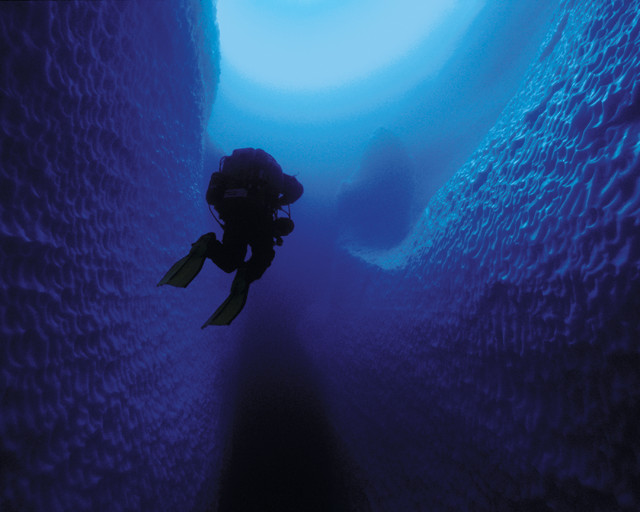
Heinerth's diving partner emerging from an iceberg cave in Antarctica. Credit: Jill Heinerth, IntoThePlanet.com
BA: What was it like diving in an iceberg?
JH: It was both beautiful and alluring, but also quite scary. Icebergs are constantly moving and morphing, calving and rolling. The dives were unpredictable and risky. On the first exploration of an iceberg cave, Paul and I cautiously entered a deep underwater crevasse and found a gaping fissure that extended out of sight, and sheer white walls dropped interminably in a narrow crack. We swam into the fracture a good distance and drifted down to the seafloor. As we hit 39 meters, we discovered that the berg was undercut and we could continue our swim below the mass. We found a dazzling world of colorful tunicates [marine invertebrates], sea stars and curious creatures.
BA: Do you ever get nervous before a dive?
JH: It is important to be a little nervous. It means you have self-respect and understand that what you are doing is risky. The nervousness is also a sign that you are doing something cutting edge, and discovery is on the horizon. I try to mentally rehearse everything that can possibly go wrong and work through the solutions in my head. Then, when I jump in the water, I am free of gremlins. I already know that I have all the gear needed and the mental preparation to deal with a worst-case scenario.
BA: How do you prepare for a dive to ensure your safety?
JH: Diving preparation includes many facets, from physical fitness and technical dive training to gear maintenance and careful planning. It also requires very careful and honest risk assessment. Some of the dives that I embark on could easily result in death if not executed well. I have to sit back and decide whether the reward is worth the risk. That risk involves far more than me. The decision I make could affect my husband and family, it could put rescuers at risk, it could close sites and access.
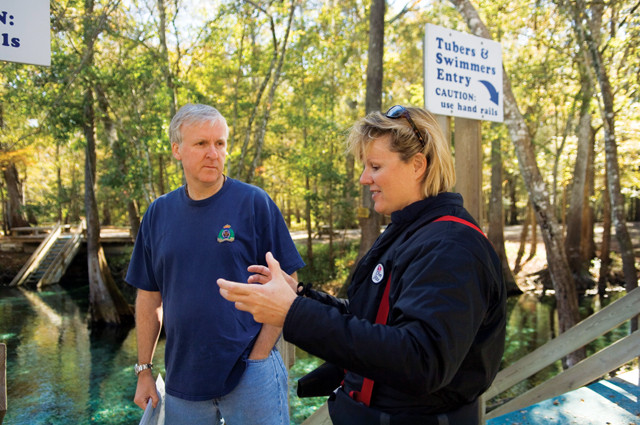
Heinerth with filmmaker James Cameron at Ginnie Springs in Florida. Credit: Jacqueline Windh.
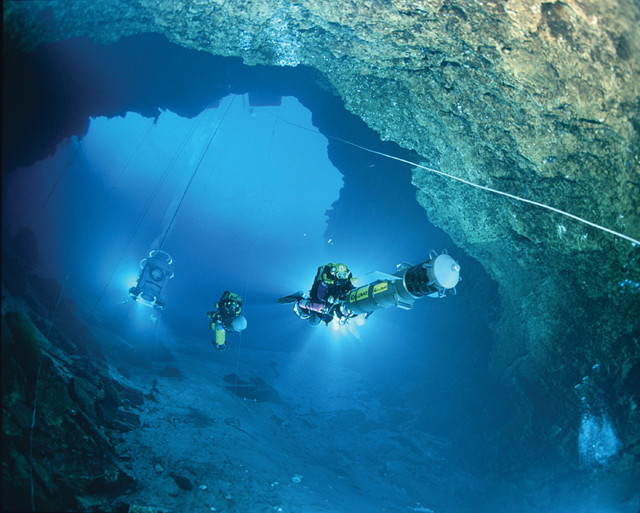
Heinerth driving a 3-D Digital Wall Mapper in Wakulla Springs in Florida. Credit: courtesy of the U.S. Deep Caving Team Inc./Wes Skiles.
In terms of gear prep, I may take hours to fill tanks with exotic gases such as helium mixes for deep dives. I prepare my life-support equipment — my rebreather — using a checklist and correct any issues that I find.
Protocols are important, and they need to be rigid if you want to survive cave diving. Siltouts, gas emergencies, entanglement, broken lines and other emergencies are all practiced in basic cave training. Those skills need to be continually refreshed so you are sharp and ready to deal with problems effectively.
BA: Have you had any life-threatening situations underwater?
JH: Plenty! I have been behind a diver who was stuck and blocking my exit. I have been pinned down by the current inside an Antarctic iceberg. I have shared a small pond with a large alligator and been hidden behind an iceberg, out of sight from the crew boat. All were scary, but also empowering. If you get the right training and carry appropriate equipment and always plan for the worst, then you can get yourself out of most problems.
BA: How did you get separated from the boat in Antarctica?
JH: We surfaced and could not see the boat after being swept through the iceberg and deposited on the far side. As I looked up, all I could see was towering ice all around me. When we surfaced, our eyes were less than 30 centimeters above the surface of the water and pack ice was higher than our horizon. Worse yet, bigger chunks of ice completely obscured our view. The boat was “around the corner” on the other side of a towering face of ice that rose almost 60 meters above our heads. There was no way we could see them or they could see us until the boat was dislodged from its anchorage by the gaining momentum of the current. As they tried to reset the anchor, they drifted backward, came by the corner of the iceberg and spotted our tiny heads in the water, carrying a meager 2-meter-high safety sausage — an orange inflatable marker buoy.
BA: Tell me about one of your favorite projects.
JH: About 16 years ago, I was part of the U.S. Deep Caving Team that mapped the underwater cave system of Wakulla Springs on the Florida panhandle, led by Bill Stone, a diver, engineer and cave explorer.
The project produced the first accurate three-dimensional map of an underground conduit — dry or wet — and we connected that underground topography to the surface using ultra-low-frequency radio beacons. Using the same technology, I have traveled beneath a golf course, restaurant and bowling alley. For the first time in history, people could walk across the surface of the Earth and know precisely where drinking water conduits lay beneath their feet. And for the first time, I really felt that our work was having an important educational outreach effort that went far beyond the cave diving community.
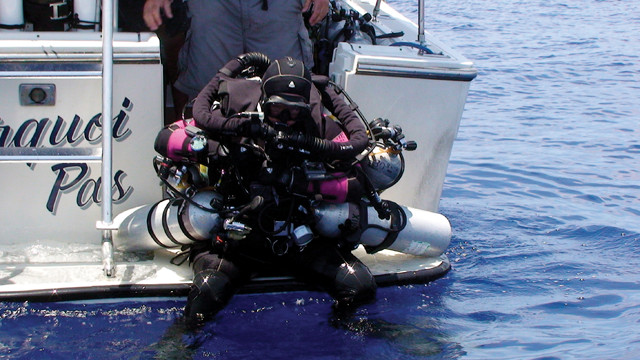
During a NOAA project studying global climate change, Heinerth prepares to make the deepest dive ever conducted in the Bermuda Deep. Credit: Nic Alvarado.
Soon, I will be working with Stone again as he tests a small autonomous version of that mapper. He is still working with NASA using other iterations of the mapper with plans to map the ocean beneath the frozen surface of Europa, one of Jupiter’s moons.
BA: Has your diving experience led to any surprising opportunities?
JH: I was the stunt diver for the pitch trailer for “Sanctum,” the 2011 film about trapped underwater cave divers, by James Cameron, who came to Florida to work on his new 3D underwater housing and techniques with our team. I took him on his first cave dives and then served as stunt diver for the shoot. He loves underwater exploration, so I think he really enjoyed our caves.
BA: What is next for you? Are there still places to explore?
JH: There is always something left to explore; I have a very long list. These days I am inspired by work I am doing with a team from National Geographic whose goal is digital preservation. Artifacts inside caves and underwater are relatively well protected and preserved while they are underwater. If they are disturbed or removed, however, then cultural history is lost. This team is doing extremely high-resolution three-dimensional scanning to create virtual and real models of priceless items that should remain where they are. All the scanning is done underwater, in situ, and that means the item retains its context and is preserved for future study. I am now headed to scan some important cultural and paleontological remains in Mexican cenotes.
There is still so much to learn about underwater caves. The science is exhaustive, but that gives me many more opportunities ahead to learn and document the work of scientists all over the world.
© 2008-2021. All rights reserved. Any copying, redistribution or retransmission of any of the contents of this service without the expressed written permission of the American Geosciences Institute is expressly prohibited. Click here for all copyright requests.